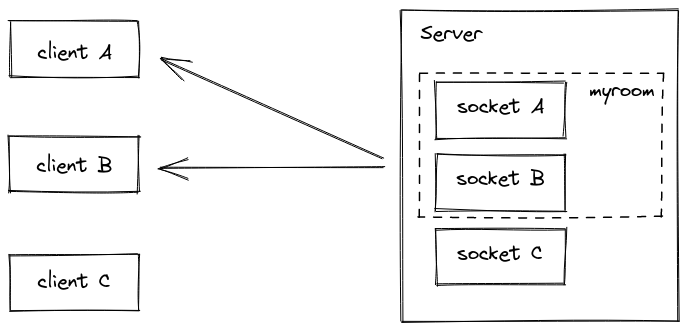# WebSocket
WIP
This feature is in experimental
WebSockets allow for two-way communication between a client and server. Unlike HTTP, which has a request and response pattern, WebSocket peers can send an arbitrary number of messages in either direction. Jiny's WebSocket API allows you to create both clients and servers that handle messages asynchronously.
# Install
Latest version:
build.gradle
dependencies {
compile group: 'com.jinyframework', name: 'websocket', version: '{latest_version}'
}
# Server
WebSocket server can be spawn like this:
import com.jinyframework.websocket.WebSocketServer;
public class Main {
public static void main(String[] args) {
val wsServer = WebSocketServer.port(1234);
wsServer.start();
# Messages
The WebSocketServer class has methods for sending and receiving messages as well as listening for events. WebSockets can transmit data via text format. Text messages are interpreted as UTF-8 strings.
Message contains two parts: topic and message.
# Sending
Messages can be sent to all connected WebSocket clients using the WebSocket's emit method:
wsServer.emit('topicA', 'sample message');
# Receiving
Incoming messages are handled via the .on callbacks.
// Listen on topic 'hello'
io.on("hello", (socket, message) -> {
socket.emit("hi");
// Only send Hi to the WebSocket client
// who sent message on "hello" topic
});
# Handshake
Define a handshake process for websocket connection:
// Return identify string or reject by throwing exeptions
wsServer.handshake(req -> {
val token = req.getFieldValue('cookie');
try {
val userId = validateToken(token);
return userId;
} catch(Exception e) {
throw e;
}
});
# Room
You can define arbitrary channels called “Rooms” that sockets can join and leave.
This is useful to broadcast data to a subset of sockets:

# Joining and leaving
You can call join to subscribe the socket to a given channel:
wsServer.on("room/join", (socket, roomName) -> socket.join(roomName)); // Join room
wsServer.on("room/leave", (socket, roomName) -> socket.leave(roomName)); // Leave room
And then simply use emitRoom when broadcasting or emitting to rooms:
wsServer.emitRoom('room1', 'topicA', 'sample message');
# Sample use cases
# Broadcast data to each device / tab of a given user
wsServer.onOpen(socket -> {
val userId = socket.getIdentify();
socket.join(userId);
// and then later
wsServer.emitRoom(userId, 'topicA', 'hi');
});
# Client
Sample WebSocket Client usage:
import com.jinyframework.websocket.WebSocketClient;
val client = WebSocketClient.builder()
.uri("ws://localhost:1234")
.build().connect();
client.on("chat/global", message -> {
System.out.println("New global chat: " + message);
});
client.on("pong", message -> {
System.out.println("Pong: " + message);
});
client.emit("chat/global", "Hello World");
client.emit("ping", "Ping message");

